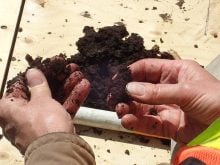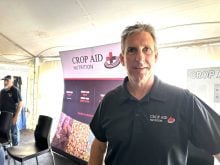Should Manitoba potato growers be following the example of their counterparts south of the border and begin incorporating soil fumigation with Vapam into their management practices?
Mario Tenuta, a soil scientist with the University of Manitoba, has been looking into the question, but says drawing conclusions would be premature.
“We’re really just starting to get the information to evaluate,” he told growers attending a production meeting last winter.
Manitoba soils contain many of the same soil-borne organisms our American cousins are trying to take care of, in particular the disease nexus known as potato early dying complex. It appears to be the work of a number of soil-borne pathogens, the most prominent of which is verticillium, which then works either alone or in concert with other soil-borne pathogens like black dot or soft rot.
Read Also

What is perfect Christmas weather?
What is ‘perfect’ Christmas weather on the Prairies? Here’s where you should head this holiday, according to historical weather data.
It shows up in August as vascular wilting and browning and is often evident in patches in the field. When the stem is cut to see what’s going on, the water-conducting tissues known as xylem are found to be clogged.
“It robs overall yield and yield of large tubers,” he said. “It impacts late tuber bulking. The plant isn’t able to grow as long, which really impacts putting extra weight on the tubers.”
One trial near Carberry found the highest incidence of early dying coincided with the lowest number of six- to 10-ounce tubers at harvest.
“When you have higher disease incidents, the number of tubers really starts dropping and it really shows up in the six- to 10-ounce range,” he said. “It is a concern and it’s robbing you of yield. How do we tackle it?”
Biggest problem
Predicting whether there’s going to be a problem is difficult, Tenuta said. Soil testing for the verticillium inoculum in the spring, for example, has shown poor correlation with disease later in the season. In some cases there can be huge loads and the disease doesn’t show up, and in other cases it can be all but absent and the disease surfaces.
There’s also the question of just how high the verticillium counts are in Manitoba soils. American growers frequently said if there are 10 or 15 found in a soil sample, it’s time to fumigate before planting. They’re being found at levels as high as 300 or 400 in Manitoba.
“I shake my head when I see those numbers,” Tenuta said. “It’s quite interesting, we’ve got some peculiar circumstances in Manitoba.”
One place where verticillium counts and disease do correlate is in after-harvest testing, where testing is essentially revealing the inoculum present in the soil from the diseased plants that growing season.
“Of course this isn’t something we can use as a tool, because it’s too late,” Tenuta said.
Insurance treatments
This difficulty has led growers in other regions to essentially embark on a program of soil fumigation as a matter of course, using metam sodium, more commonly known by its trade name Vapam. It’s either applied through irrigation pivots or is shanked in. Soil temperature and moisture must be “decent” to ensure efficacy, Tenuta said.
“It combines with water and produces something similar to mustard gas,” Tenuta said. “It’s not specific, like a biocide or pesticide. It will kill lots of things, including verticillium.”
Tenuta ran his first trial in 2007, near Shilo, on sandy soil irrigated through a centre pivot, with treated and untreated areas. Soil testing showed a substantial reduction in verticillium, with a 50 per cent kill within three days. Petiole testing in July and early August, however, showed that soil inoculum control didn’t necessarily translate to inoculum control in the plants.
“Where there was no Vapam, there were incidents in 74 per cent of the samples,” Tenuta said. “Where there was Vapam, there were incidents in 84 per cent.”
Early dying also followed this trend with just 61 per cent of the control showing early dying, and a near-ubiquitous 90 per cent early dying seen in the Vapam treatment. Yields also didn’t get better with Vapam. If anything, they got worse.
“Was it a phytotoxicity issue?” Tenuta said. “We have to be extremely careful here — it was our first experience.”
No yield improvement
That fall they followed up with a program of fall Vapam applications on ground where potatoes would be planted in the spring of 2008 and ran head-to-head trials with other treatments that saw compost and mustard meal. Again the Vapam treatment didn’t fare that well when soil counts were done in the fall of 2008, despite all but eliminating the inoculum from the soil.
“Vapam was the one that went up,” Tenuta said. “It appears the soil was reinoculated by plants from that season. The best treatments were compost and mustard meal.”
Lately he’s been doing head-to-head comparisons of the soil fumigant and compost, using both hog and cattle manure, which he said he suspects will be a strong indicator of the effectiveness of Vapam.
Summing up his research he told growers Vapam does reduce inoculum, but the accompanying disease reduction hasn’t been found. He also stressed that the high levels of verticillium in our soils are concerning and may be due to the higher organic matter levels Manitoba enjoys. He also said there are questions about Vapam use and the “legacy effects” such as what it’s going to do to helpful organisms in the soil that might prevent disease outbreaks.
“Are we going to see a situation where we have more disease, so we’re going to be locked into applying Vapam?” he said.
He also conceded that there’s no clear reason that compost seemed to lower disease incidents.
“It’s not toxic, and the verticillium didn’t die — it just hung out there in the soil,” Tenuta said. “Maybe the compost contributed to keeping the fungus sleeping, or maybe it made the plant itself more efficient at keeping verticillium out.”















